Intel's Pentium M Desktop Part II: ASUS' Pentium M to Pentium 4 Socket Adapter
by Anand Lal Shimpi on March 24, 2005 1:31 PM EST- Posted in
- CPUs
Business/General Use Performance
Business Winstone 2004
Business Winstone 2004 tests the following applications in various usage scenarios:- Microsoft Access 2002
- Microsoft Excel 2002
- Microsoft FrontPage 2002
- Microsoft Outlook 2002
- Microsoft PowerPoint 2002
- Microsoft Project 2002
- Microsoft Word 2002
- Norton AntiVirus Professional Edition 2003
- WinZip 8.1
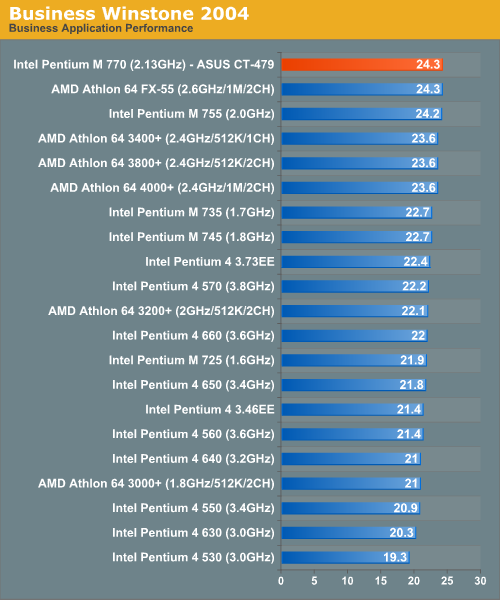
Office Productivity SYSMark 2004
SYSMark's Office Productivity suite consists of three tests, the first of which is the Communication test. The Communication test consists of the following:"The user receives an email in Outlook 2002 that contains a collection of documents in a zip file. The user reviews his email and updates his calendar while VirusScan 7.0 scans the system. The corporate web site is viewed in Internet Explorer 6.0. Finally, Internet Explorer is used to look at samples of the web pages and documents created during the scenario."
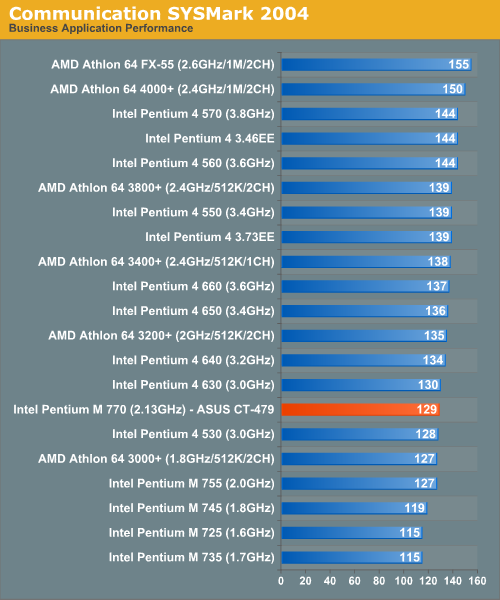
The next test is Document Creation performance:
"The user edits the document using Word 2002. He transcribes an audio file into a document using Dragon NaturallySpeaking 6. Once the document has all the necessary pieces in place, the user changes it into a portable format for easy and secure distribution using Acrobat 5.0.5. The user creates a marketing presentation in PowerPoint 2002 and adds elements to a slide show template."
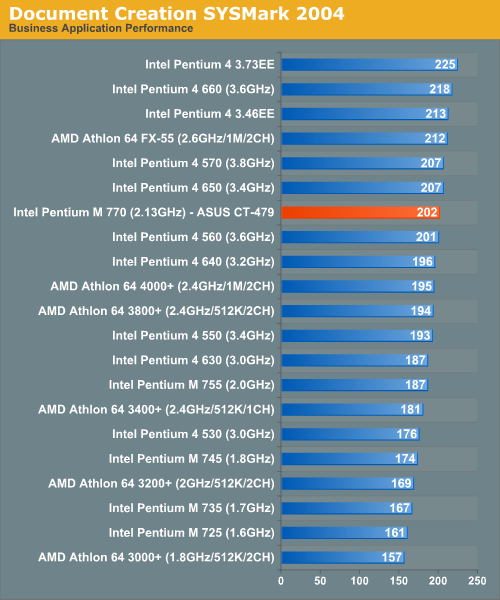
The final test in our Office Productivity suite is Data Analysis, which BAPCo describes as:
"The user opens a database using Access 2002 and runs some queries. A collection of documents are archived using WinZip 8.1. The queries' results are imported into a spreadsheet using Excel 2002 and are used to generate graphical charts."
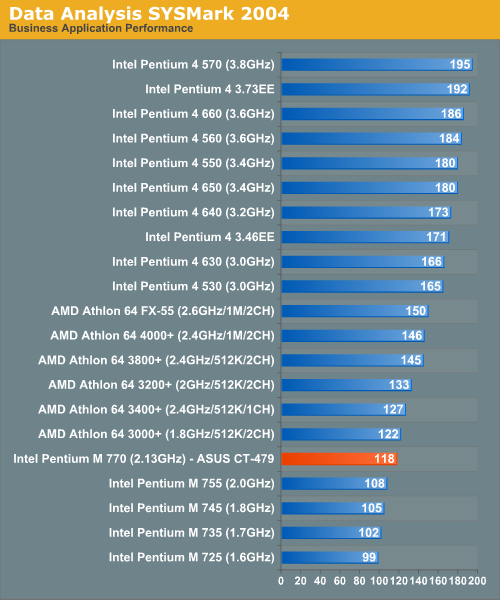
Mozilla 1.4
Quite possibly the most frequently used application on any desktop is the one that we pay the least amount of attention when it comes to performance. While a bit older than the core that is now used in Firefox, performance in Mozilla is worth looking at as many users are switching from IE to a much more capable browser on the PC - Firefox.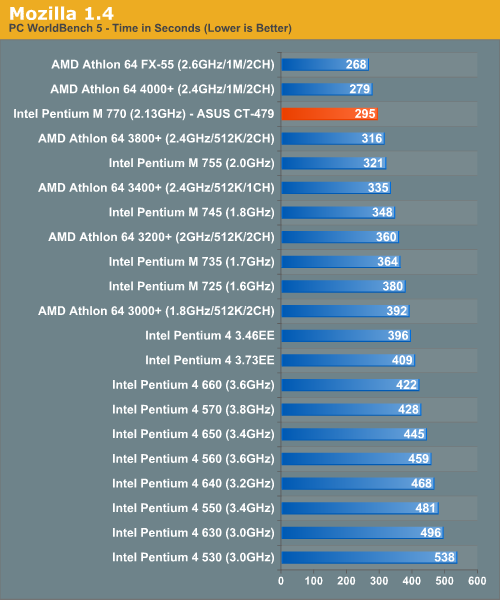
ACD Systems ACDSee PowerPack 5.0
ACDSee is a popular image editing tool that is great for basic image editing options such as batch resizing, rotating, cropping and other such features that are too elementary to justify purchasing something as powerful as Photoshop. There are no extremely complex filters here, just pure batch image processing.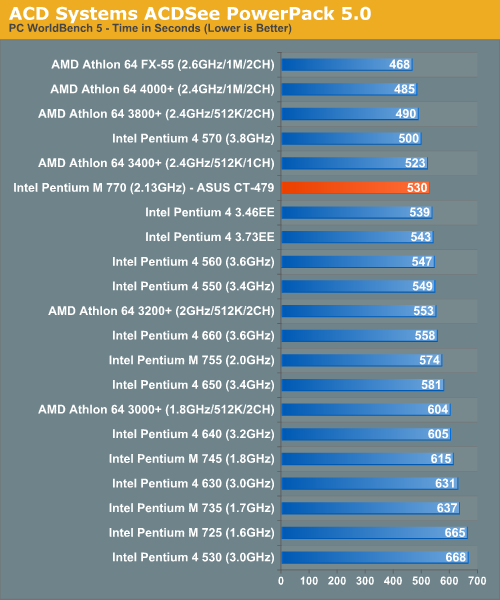
Winzip
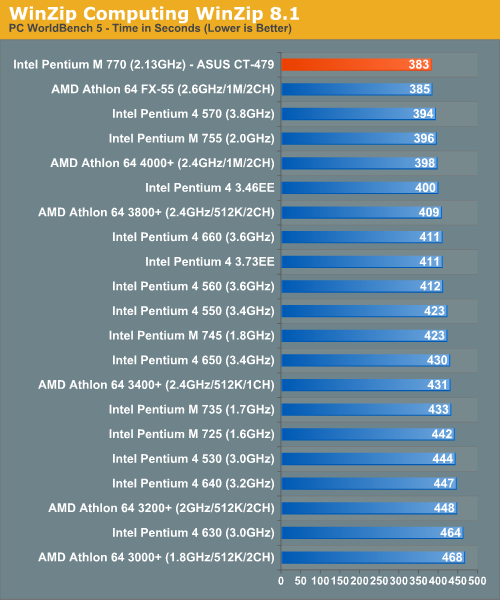
Let's look at how its peak theoretical performance is under WinRAR's built in benchmark:
WinRAR 3.40
Pulling the hard disk out of the equation, we can get a much better idea of which processors are truly best suited for file compression.










48 Comments
View All Comments
Spajky - Saturday, May 14, 2005 - link
Spajky - Saturday, May 7, 2005 - link
Some comments:http://www.anandtech.com/cpuchipsets/showdoc.aspx?...
>WinRAR 3.40
Pulling the hard disk out of the equation, we can get a much better idea of which processors are truly best suited for file compression<
>The WinRAR test is particularly memory bandwidth intensive, so the move to a platform that can feed the Pentium M adequately increases performance tremendously. However, even with the boost, the best that the Pentium M can do is match the performance of Intel desktop CPUs. It still can't touch the Athlon 64s<
Data compression, WinRAR 3.42, KB/s - Irrelevant CPU bench/graph !!!
It can be treated as a real life memory subsystem benchmark instead !
WinRAR´s built_in benchmark & hardware test" is NOT a Data Compression Bench :
some tests/benchmarks & explanation HOW IT WORKS, here:
http://freeweb.siol.net/jerman55/HP/benchMem.htm
Spajky - Saturday, May 7, 2005 - link
Some comments:http://www.anandtech.com/cpuchipsets/showdoc.aspx?...
>WinRAR 3.40
Pulling the hard disk out of the equation, we can get a much better idea of which processors are truly best suited for file compression<
>The WinRAR test is particularly memory bandwidth intensive, so the move to a platform that can feed the Pentium M adequately increases performance tremendously. However, even with the boost, the best that the Pentium M can do is match the performance of Intel desktop CPUs. It still can't touch the Athlon 64s<
Data compression, WinRAR 3.42, KB/s - Irrelevant CPU bench/graph !!!
It can be treated as a real life memory subsystem benchmark instead !
WinRAR´s built_in benchmark & hardware test" is NOT a Data Compression Bench :
some tests/benchmarks & explanation HOW IT WORKS, here:
http://freeweb.siol.net/jerman55/HP/benchMem.htm
Spajky - Saturday, May 7, 2005 - link
Some comments:http://www.anandtech.com/cpuchipsets/showdoc.aspx?...
>WinRAR 3.40
Pulling the hard disk out of the equation, we can get a much better idea of which processors are truly best suited for file compression<
>The WinRAR test is particularly memory bandwidth intensive, so the move to a platform that can feed the Pentium M adequately increases performance tremendously. However, even with the boost, the best that the Pentium M can do is match the performance of Intel desktop CPUs. It still can't touch the Athlon 64s<
Data compression, WinRAR 3.42, KB/s - Irrelevant CPU bench/graph !!!
It can be treated as a real life memory subsystem benchmark instead !
WinRAR´s built_in benchmark & hardware test" is NOT a Data Compression Bench :
some tests/benchmarks & explanation HOW IT WORKS, here:
http://freeweb.siol.net/jerman55/HP/benchMem.htm
Anemone - Sunday, April 17, 2005 - link
Curious how the XPS Gen2 would have faired in this battery of testing... the 915M seems to slightly better exploit the P-M from what I've been seeing, even though the XPS doesn't really focus on things other than gaming. However it would show what a performance focused chipset (and one that is meant to attempt to bring out the most in Dothan) is able to do under these same conditions. Yonah seems to be the magic juice though, but its sad that is really so far away from market. Intel would do well if they could bring Yonah faster to market, even if they had to keep speeds to the 2.2-2.4 range to do it.Quite an interesting article, and one I read carefully on every point.
ty
Calin - Tuesday, March 29, 2005 - link
An overclocked PM on top of the competition - even in a single benchmark? This chip is a big win for Intel, too bad that the big money come from the laptop world, where there is no competition. This is a guarantee for never decreasing prices for the Pentium M platformZebo - Monday, March 28, 2005 - link
Why's it so expensive? As far as overclocking, I don't see as it has value compared to A64, an already better rounded processor. You get a A64 3000 (which BTW has PCIe support) for $145 slam it to 2600Mhz pretty easy, 2900Mhz when Veince comes and it will destory any clock you can get out of PM. $145 super screamer :::slobber:::Meh. I'm not as excited as I once was about this chip. Everyone was saying how it's bandwidth staved in the 855 reveiws, turns out, yet again this was wishful thinking for the PM crowd desperate to see any light at end of intel tunnel. I notice no change in benchmarks with added BW.:|
fitten - Sunday, March 27, 2005 - link
#33, there's also the issue about how many data pins are exposed to the outside world. System memory DDR is 64-bits wide, as is the data bus external to the Pentium-M. Having dual channel (basically 128-bit wide memory) memory will help because the memory controller can read, in effect, two times the width each clock, but it still takes two transfers to get it across. The Athlon64 (S939 and S940) have 128-bit wide paths to memory and can transfer the entire width each transfer.valnar - Sunday, March 27, 2005 - link
I think many people, including Anand, are missing the point of the Pentium M. It was made to be a low powered, low heat processor. The fact it can even HANG with the big boys at their level is a remarkable achievement. (You can't say that about the VIA C3 processor.)Megahertz for megahertz, and watt for watt, it is easily the best processor on the market. You're comparing that against 3.8Ghz CPU's!! Of course it won't be first place. After all, it's just a 2.13Ghz. It uses 1/4 the power of the highest P4's. Compared against any other processor which comes close to those speed/power specs, it'll wipe the floor with them.
If Shuttle made their XPC's with this processor, I'd buy it in a heartbeat.
Rob
Slaimus - Sunday, March 27, 2005 - link
The real gem is the Celeron M Dothan. Need some benchmarks for that chip.